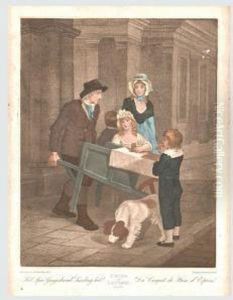F. Wheathey Paintings
Francis Wheatley was an English portrait and landscape painter. Born on February 19, 1747, in London, Wheatley exhibited a natural talent for art at a young age. He studied at the Royal Academy Schools in London, where he developed his skills and was influenced by the works of his contemporaries. Early in his career, Wheatley made a name for himself as a portrait painter, which was a lucrative field at the time. However, he did not limit himself to portraits alone and also painted landscapes and genre scenes.
Wheatley's life was marked by both professional success and personal difficulties. In the 1770s, he traveled to Ireland to escape debt and lived there for several years. During his time in Ireland, Wheatley's work was well-received, and he gained considerable recognition. He was particularly noted for his depictions of the Irish countryside and the lives of the local people. His series of paintings depicting the Volunteer movement in Ireland, which was a response to the threat of French and Spanish invasion, was particularly well-regarded.
After returning to England, Wheatley became a member of the Royal Academy in 1791. Despite his membership, he struggled financially and was often in debt. Nevertheless, he continued to produce a substantial body of work that included rural scenes, which were popular with the British public. One of his most famous series of paintings is the 'Cries of London,' which represents street vendors in London. These works were exhibited at the Royal Academy and gained much popularity for their charm and detail.
Wheatley's style was characterized by its elegance and attention to detail. His ability to capture the character and mood of his subjects was highly praised. He was also known for his use of light and his skill in composition. Unfortunately, Wheatley's life was relatively short; he died in London on June 28, 1801. Despite his financial struggles, Wheatley left behind a legacy as a talented painter who was able to capture the essence of English and Irish life during the late 18th century.
